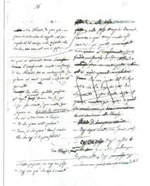|
 |
Home Page >
Biographical pathway > 1821-1827 > Rewriting
 Rewriting Rewriting
 Having decided definitively not to publish Fermo e Lucia as a self-sufficient work, Manzoni devoted his energies to rewriting his novel, sometimes making enormous changes to both the form and content of his prima minuta. The revision process was long and tormented, with a second draft entitled Gli sposi promessi reaching the stage of final corrections for the Censors. As with the 1840-42 edition, Manzoni did not refrain from adjusting the proofs as well, driven as he was by an almost obsessive dissatisfaction with the outcome. Initially he wrote the changes in the left-hand columns of the pages of his first draft which (as usual) took up only the right-hand column. Later on, since one column did not provide enough space for the changes he was making to the original text, he gradually added new sheets, often moving and mixing the old ones, according to the requirements of the plot, which had now become more complex. As with his first draft, also in the rewriting Manzoni requested and took into account his literary friends’ comments. In spite of this collaboration, the rewriting proceeded slowly. The first of the three volumes of the new novel (Chapters I-XI) was printed in October 1824. Rewriting the second volume (Chapters XII-XXIV), which was printed in October 1825, proved more laborious. Work on the third volume was even slower and more troublesome, for both literary and personal reasons. In his letters during these months Manzoni frequently refers to his “disenchantment” with the novel, which he often described jokingly in negative terms (a long-winded yarn, a rigmarole tale, etc). Moreover, it is clear that he wanted to be finished with what had become for him a burden. This anxiety of closure was accompanied by various, possibly psychosomatic, symptoms that worsened during the extremely slow revision of Chapters XXXIII-XXXIV, namely the point marking the move towards the end of the story and a novelistic “happy ending” which quite probably was not to Manzoni’s satisfaction. Having decided definitively not to publish Fermo e Lucia as a self-sufficient work, Manzoni devoted his energies to rewriting his novel, sometimes making enormous changes to both the form and content of his prima minuta. The revision process was long and tormented, with a second draft entitled Gli sposi promessi reaching the stage of final corrections for the Censors. As with the 1840-42 edition, Manzoni did not refrain from adjusting the proofs as well, driven as he was by an almost obsessive dissatisfaction with the outcome. Initially he wrote the changes in the left-hand columns of the pages of his first draft which (as usual) took up only the right-hand column. Later on, since one column did not provide enough space for the changes he was making to the original text, he gradually added new sheets, often moving and mixing the old ones, according to the requirements of the plot, which had now become more complex. As with his first draft, also in the rewriting Manzoni requested and took into account his literary friends’ comments. In spite of this collaboration, the rewriting proceeded slowly. The first of the three volumes of the new novel (Chapters I-XI) was printed in October 1824. Rewriting the second volume (Chapters XII-XXIV), which was printed in October 1825, proved more laborious. Work on the third volume was even slower and more troublesome, for both literary and personal reasons. In his letters during these months Manzoni frequently refers to his “disenchantment” with the novel, which he often described jokingly in negative terms (a long-winded yarn, a rigmarole tale, etc). Moreover, it is clear that he wanted to be finished with what had become for him a burden. This anxiety of closure was accompanied by various, possibly psychosomatic, symptoms that worsened during the extremely slow revision of Chapters XXXIII-XXXIV, namely the point marking the move towards the end of the story and a novelistic “happy ending” which quite probably was not to Manzoni’s satisfaction.
 
|
|
 |
 |
 |
 |
 |
 |
    |
